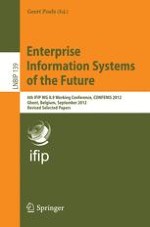This book constitutes the proceedings of the 6th International IFIP Working Conference on Research and Practical Issues of Enterprise Information Systems (CONFENIS 2012), held in Ghent, Belgium, during September 19–21, 2012. The theme of the conference was "enterprise information systems of the future –– evolving toward more performance through transparency and agility," mirroring the trend toward more open and more flexible systems.
In all, 53 contributions were submitted and after a rigorous review process 10 full papers and 15 short papers were selected for publication in this book. These 25 papers present a well-balanced mix between the traditional social sciences and the novel design science paradigms in enterprise information systems research, and they also include practitioner-oriented and practice-driven contributions. The topics covered fall into three categories: information management in businesses (e.g., enterprise modeling or business process management), information systems from a management perspective (e.g., service innovation, business intelligence, or decision support systems), and ERP offerings and implementations (e.g., software as a service or ERP case studies).
